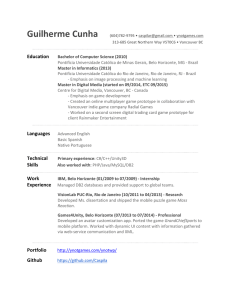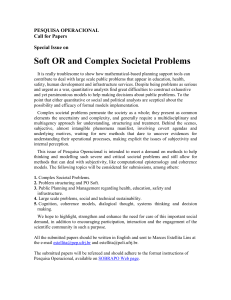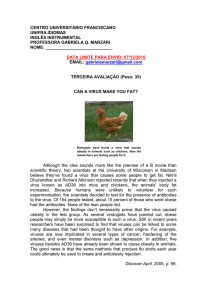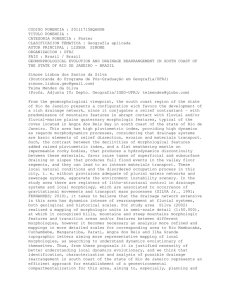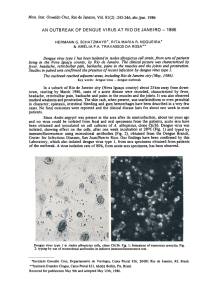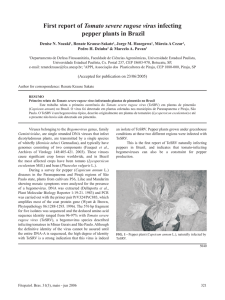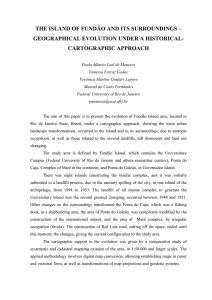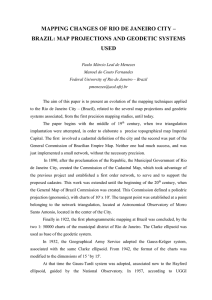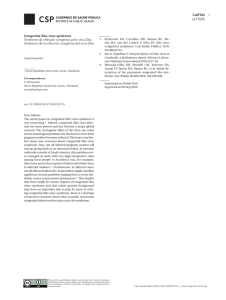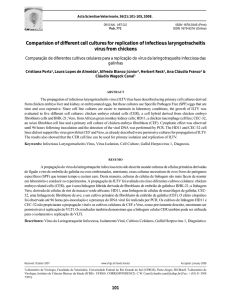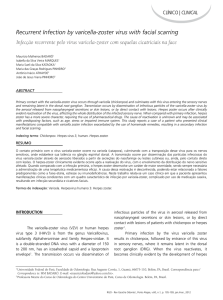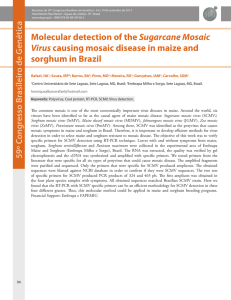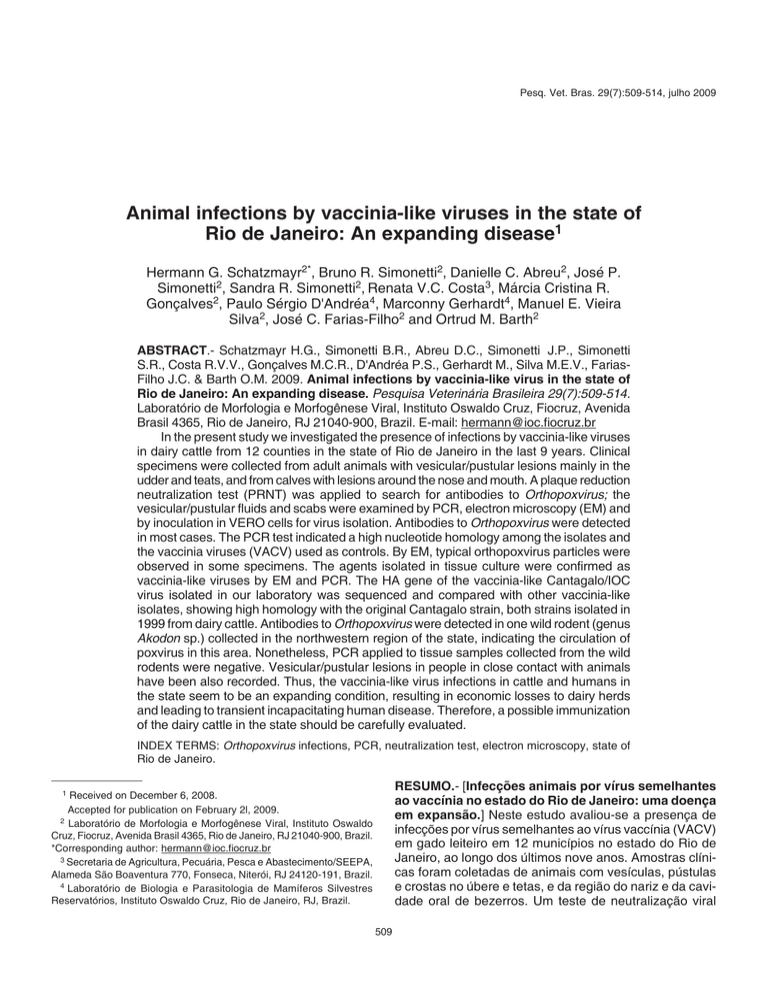
Pesq. Vet. Bras. 29(7):509-514, julho 2009
Animal infections by vaccinia-like viruses in the state of
Rio de Janeiro: An expanding disease1
Hermann G. Schatzmayr2*, Bruno R. Simonetti2, Danielle C. Abreu2, José P.
Simonetti2, Sandra R. Simonetti2, Renata V.C. Costa3, Márcia Cristina R.
Gonçalves2, Paulo Sérgio D'Andréa4, Marconny Gerhardt4, Manuel E. Vieira
Silva2, José C. Farias-Filho2 and Ortrud M. Barth2
ABSTRACT.- Schatzmayr H.G., Simonetti B.R., Abreu D.C., Simonetti J.P., Simonetti
S.R., Costa R.V.V., Gonçalves M.C.R., D'Andréa P.S., Gerhardt M., Silva M.E.V., FariasFilho J.C. & Barth O.M. 2009. Animal infections by vaccinia-like virus in the state of
Rio de Janeiro: An expanding disease. Pesquisa Veterinária Brasileira 29(7):509-514.
Laboratório de Morfologia e Morfogênese Viral, Instituto Oswaldo Cruz, Fiocruz, Avenida
Brasil 4365, Rio de Janeiro, RJ 21040-900, Brazil. E-mail: [email protected]
In the present study we investigated the presence of infections by vaccinia-like viruses
in dairy cattle from 12 counties in the state of Rio de Janeiro in the last 9 years. Clinical
specimens were collected from adult animals with vesicular/pustular lesions mainly in the
udder and teats, and from calves with lesions around the nose and mouth. A plaque reduction
neutralization test (PRNT) was applied to search for antibodies to Orthopoxvirus; the
vesicular/pustular fluids and scabs were examined by PCR, electron microscopy (EM) and
by inoculation in VERO cells for virus isolation. Antibodies to Orthopoxvirus were detected
in most cases. The PCR test indicated a high nucleotide homology among the isolates and
the vaccinia viruses (VACV) used as controls. By EM, typical orthopoxvirus particles were
observed in some specimens. The agents isolated in tissue culture were confirmed as
vaccinia-like viruses by EM and PCR. The HA gene of the vaccinia-like Cantagalo/IOC
virus isolated in our laboratory was sequenced and compared with other vaccinia-like
isolates, showing high homology with the original Cantagalo strain, both strains isolated in
1999 from dairy cattle. Antibodies to Orthopoxvirus were detected in one wild rodent (genus
Akodon sp.) collected in the northwestern region of the state, indicating the circulation of
poxvirus in this area. Nonetheless, PCR applied to tissue samples collected from the wild
rodents were negative. Vesicular/pustular lesions in people in close contact with animals
have been also recorded. Thus, the vaccinia-like virus infections in cattle and humans in
the state seem to be an expanding condition, resulting in economic losses to dairy herds
and leading to transient incapacitating human disease. Therefore, a possible immunization
of the dairy cattle in the state should be carefully evaluated.
INDEX TERMS: Orthopoxvirus infections, PCR, neutralization test, electron microscopy, state of
Rio de Janeiro.
RESUMO.- [Infecções animais por vírus semelhantes
ao vaccínia no estado do Rio de Janeiro: uma doença
em expansão.] Neste estudo avaliou-se a presença de
infecções por vírus semelhantes ao vírus vaccínia (VACV)
em gado leiteiro em 12 municípios no estado do Rio de
Janeiro, ao longo dos últimos nove anos. Amostras clínicas foram coletadas de animais com vesículas, pústulas
e crostas no úbere e tetas, e da região do nariz e da cavidade oral de bezerros. Um teste de neutralização viral
1
Received on December 6, 2008.
Accepted for publication on February 2l, 2009.
2 Laboratório de Morfologia e Morfogênese Viral, Instituto Oswaldo
Cruz, Fiocruz, Avenida Brasil 4365, Rio de Janeiro, RJ 21040-900, Brazil.
*Corresponding author: [email protected]
3 Secretaria de Agricultura, Pecuária, Pesca e Abastecimento/SEEPA,
Alameda São Boaventura 770, Fonseca, Niterói, RJ 24120-191, Brazil.
4 Laboratório de Biologia e Parasitologia de Mamíferos Silvestres
Reservatórios, Instituto Oswaldo Cruz, Rio de Janeiro, RJ, Brazil.
509
510
Hermann G. Schatzmayr et al.
por redução de placas foi desenvolvido para investigar a
presença de anticorpos contra Orthopoxvirus. Os fluidos
de vesículas / pústulas e as crostas foram testadas por
PCR, microscopia eletrônica (ME) e por inoculação em
células VERO para isolamento viral. Anticorpos contra
Orthopoxvirus foram detectados na grande maioria dos
animais. O teste de PCR demonstrou homologia entre os
vírus isolados e amostras de vírus vaccínia usados como
controles. Na ME, partículas típicas de Orthopoxvirus foram observadas em vários espécimes analisados. Os vírus isolados em cultivo celular foram confirmados como
Orthopoxvirus por PCR e ME. O gene HA da amostra
Cantagalo/IOC isolada em nosso laboratório foi seqüenciado e comparado com outras amostras semelhantes ao
vaccínia, mostrando uma alta homologia com a amostra
original Cantagalo, tendo sido as duas amostras isoladas
em 1999 de gado leiteiro. Anticorpos para Orthopoxvirus
foram detectados em um roedor silvestre do gênero
Akodon sp. coletado na região noroeste do estado, sugerindo uma circulação de poxvírus na natureza. No entanto, os testes de PCR aplicados a tecidos de roedores silvestres foram negativos. Infecções vesiculares / pustulares
em humanos que mantinham contato com os animais afetados também foram relatadas. Assim, infecções por
amostras semelhantes ao vírus VACV em bovinos e em
humanos parecem em expansão no estado, gerando perdas econômicas em animais e quadros de doença
incapacitante temporária em pacientes humanos. Dessa
forma, a possibilidade da imunização do gado leiteiro no
estado deve ser devidamente avaliada.
molecular level as a vaccinia-like virus that resembled the
vaccinia/IOC strain used for vaccine preparation in the past
(Damaso et al. 2000). Later on, other orthopoxviruses,
isolated mainly in the southeastern region of the country
were also confirmed as vaccinia-like poxviruses (Schatzmayr et al. 2000, 2005, De Souza Trindade et al. 2003,
Nagasse-Sugahara et al. 2004). The present article
describes studies carried out in 12 counties in the northwestern and Paraíba river valley regions of Rio de Janeiro state (RJ) over the last 9 years. These studies aimed to
confirm the presence of poxviruses in skin lesions of
animals and the presence of human infections related to
the animal disease, to characterize the circulating virus
isolates and to contribute for a better understanding of the
epidemiology of poxvirus infections in the state.
MATERIALS AND METHODS
Clinical specimens: Vesicular and pustular fluids, scabs and
blood samples from dairy cattle presenting vesicopustular
disease were received in the laboratory of Instituto Oswaldo
Cruz for diagnosis. The specimens were originated from the
municipalities of Cantagalo, Cordeiro, Santo Antonio de Padua,
Aperibé, Cambuci and Miracema in the northwestern region and
Valença, Barra do Piraí, Rio das Flores, Piraí, Rio Claro and
Resende in the Paraiba river region of the state of Rio de Janeiro
(Fig.1).
TERMOS DE INDEXAÇÃO: Infecções por Orthopoxvirus, PCR,
teste de neutralização, microscopia eletrônica, estado do Rio
de Janeiro.
INTRODUCTION
The family Poxviridae comprises a group of virus naturally
infecting humans and many other vertebrate species and
insects as well. In vertebrates, these viruses cause mainly
vesicopustular infections of different degrees of severity
(Schatzmayr & Azeredo-Costa 2005). The majority of
human poxvirus infections are zoonotic while the smallpox
virus and Molluscum contagiosum are solely human
pathogens. Among the genera which are able to infect
vertebrates, the Orthopoxvirus is the most important. This
genus includes smallpox virus, whose human infection was
eradicated from the world in 1977; rabbitpox; vaccinia virus,
which is used for vaccine preparation against smallpox;
cowpox, a zoonotic virus occurring mainly in rodents in
Europe and parts of Asia and monkeypox, which circulates
mainly in Africa in wild animals. This last virus was recently
introduced into North America by importation of pet rodents
(CDC 2003).
Since 1999, orthopoxvirus infections have been
reported in the state of Rio de Janeiro (RJ) as a zoonotic
disease, involving dairy cattle and people in contact with
the affected animals (Damaso et al. 2000; Schatzmayr et
al. 2000). The Cantagalo strain was characterized at
Pesq. Vet. Bras. 29(7):509-514, julho 2009
Fig.1. Counties in the state of Rio de Janeiro where animal
infections have been confirmed by laboratory tests.
In Paraiba river valley the county of Valença represents 35.5
% of the farms with clinical cases, followed by Barra do Piraí
with 19.3% and Resende with 16.1%. Most of the cases occured
from May to August, corresponding to the dry season. The
specimens were sent to the laboratory by animal health
authorities for etiologic confirmation Serum samples were
obtained from most cases and skin specimens were collected
only in acute cases. A total of 152 animal infections were studied,
with 41 skin and 135 blood specimens being collected and
analyzed. Data on the cases were obtained from the owners of
the animals and from field investigations carried out by one of
the authors in the Paraíba river area (RVCC).
Virus isolation: specimens collected from the skin lesions
were grounded and treated with proportional volume of Eagle
Animal infections by vaccinia-like virus in the state of Rio de Janeiro: An expanding disease
tissue culture medium plus antibiotics. The material was
inoculated in a VERO cell strain permissive to poxvirus. The
inoculated cells were observed for cytopathic effect (CPE) and
the presence of the virus was confirmed by electron microscopy
(EM) and polymerase chain reaction (PCR).
Electron microscopy: fragments of skin and vesicular fluids
were prepared for transmission EM by dilution in distilled water
and negative contrasting using PTA 1% (Brenner & Horne 1959).
Observations were then made at 30,000x magnification in a Zeiss
Electron Microscope, model 900. Tissue culture supernatants
were contrasted and observed as described.
PCR and nucleotide sequencing: briefly, external primers
(HAOUTR and HAOUTF) as previously described (Damaso
2000) were applied for amplification of a segment of 1171 bp of
the HA gene. Vaccinia-like virus strains isolated from the
municipalities of Cordeiro, Cambuci, Miracema and Aperibé and
the Cantagalo/IOC strain were included. As controls, the original
Cantagalo strain and the Wyeth-NYBH vaccinia strain were also
submitted to PCR (Fig.2). For sequencing of a genome region
of Cantagalo/IOC strain, which has been isolated in same area
and on the same occasion as the original Cantagalo strain, two
internal primers(HAINTR and HAINTF) were used.
511
areas of the municipalities of Cordeiro and Cantagalo At each
capture site, traps were set on linear transects with 20 trapping
stations at 10m intervals. All transects were geographically
positioned using the GARMINÒ GPS 12 GPS receiver, referenced to WGS-84 (World Geodetic System, 1984). We used
two types of live-traps: Sherman (H.B. Sherman Traps®, 7.62 x
9.53 x 30.48cm) and Tomahawk (Tomahawk Live Traps®, 40.64
x 12.70 x 12.70cm) to capture small mammals weighing up to 3
kg. The bait was a mixture of banana, bacon, oats and peanut
butter. The total sampling effort was 260 trap-nights in Cordeiro
and 440 trap-nights in the Paraíba do Sul locality (Cantagalo).
Preliminary identification of rodents at genus level was done
in the field by external morphology, followed by confirmation by
karyotyping (De Andrade et al. 2004).
All the animals were euthanized to carry out cytogenetic
techniques and collection of blood and organs for poxvirus
diagnosis, in accordance with bioethics protocols for animal use.
The researchers used individual protection equipment (3M HEPA
filters, biological level 3) and other biosafety methods, following
protocols approved by the Biosafety Committee of the Oswaldo
Cruz Institute. The animal trapping was licensed by the Brazilian
Institute for the Environment and Renewable Natural Resources
(Instituto Brasileiro do Meio Ambiente e dos Recursos Naturais
Renováveis, IBAMA), under license numbers 068/2005 and 225/
2006.
Serum samples from 17 rodents were tested for antibodies
as described. Tissue fragments (liver, kidneys, lungs) were also
collected and brought to the laboratory in liquid nitrogen,
grounded and analysed by PCR and virus isolation. All
techniques using the rodent specimens were carried out in a
laboratory certified at Biosafety level 3, considering the possible
presence of other pathogenic viruses in the wild animals.
RESULTS
Fig.2. Results of the PCR test for the HA gene of pox virus in
agarose gel 1.5%. Result of the amplification (approx.1107
bp) by PCR of the strains: 1- Cordeiro 509; 2- Cambuci; 3Miracema; 4- Aperibé; 5- Cordeiro 510; 6- CTGV-IOC; 7CTGV; 8- CP (VV-NYBH Wyeth); 9- CN-BIO; 10- CN-H2O;
11- Ladder 123 bp.
Sequence alignment was performed using the Clustal W
software and the phylogenetic tree was constructed using the
MEGA 3.1 software, by means of the neighbor joining method
under a matrix of genetic distances established by the Kimura
two-parameter model. The bootstrap with 1000 replications was
used to estimate the reliability of the predicted tree. The bootstrap
values are indicated at the branch points in Figure 3.
Serology: the sera were submitted to a 50% plaquereduction neutralization test (PRNT), using the Cantagalo/IOC
strain as the reference virus. Serum dilutions and a virus
suspension containing approximately 40 plaque-forming units
(pfu) in 100 microliters were incubated at 37°C for 1h in cell
culture microplates, followed by addition of a suspension of
VERO cells. After 48h, the plates were stained with crystal violet
and formaldehyde 1%, washed and the plaques were counted
under the microscope.
Rodent collection: small wild mammals were trapped in rural
Analysis of specimens collected in 12 municipalities
confirmed the association of orthopoxviruses with vesicular
disease in 152 animals, by at least one of the techniques
applied. A total of 25 orthopoxviruses were isolated in
tissue culture and/or detected by PCR.
In Figure 2, PCR amplifications of the HA gene of five
isolates are compared with the Cantagalo/IOC strain, the
original UFRJ Cantagalo strain and the Wyeth vaccinia
strain. The figure shows PCR amplification of all five
isolates, indicating homology at nucleotide level with the
controls.
Figure 3 shows a phylogenetic analysis of the HA
orthopoxvirus gene, demonstrating homology between the
Cantagalo/IOC and original Cantagalo strains and a close
relationship with the IOC vaccine strain, which has been
used as antigen for the serology.
Table 1 presents the results of the different methods
used to identify/characterize the viruses. Since PCR was
introduced in our laboratory by 1995, evaluation of
sensitivity of the tests were possible only in specimens
tested thereafter. In those samples in which PCR and virus
isolation were carried out concomitantly, the PCR test was
more sensitive, as expected.
Electron microscopy shows typical morphology of
orthopoxvirus virions (Fig.4).
Antibody testing alone was responsible for the definitive
Pesq. Vet. Bras. 29(7):509-514, julho 2009
512
Hermann G. Schatzmayr et al.
Fig.3. Phyllogenetic analysis of Cantagalo IOC strain. The
comparative analysis of the DNA sequences (gene HA of
Orthopoxvirus) was made using CLUSTAL software. The
phyllogenetic tree was constructed applying the neighborjoining method (bootstrap = 1000), using the program MEGA
3.1 (Molecular Evolutionary Genetics Analysis, Pennsylvania
State University). The genetic distance was obtained by the
proportional distance method (two paramets model, Kimura).
The reference sequences used were: Vac variants M14783,
Vac ihdw AF375121, Z99051 Wyeth, RPV rev AF375118,
Vac IOC AF229248, Cg IOC, CgAF229247, Vac len
AF375123, CPX 89 5 AF375086, MPV wmp AF375114.
Table 1. Laboratorial results of the specimens from
bovines suspected of poxvirus infection in 12 counties of
the state of Rio de Janeiro, 1999-2007
RT-PCR test
Vírus isolation
Electron microscopy
Neutralization test
Positive samples
Negative samples
22
13
16
100
09
14
09
30
diagnostic in most cases, being sera dilutions >1/10
accepted as positive In some animals, titers as high as
1280 were observed. Antibodies to orthopoxviruses were
detected at dilution of 1/20 in three subsequent antibody
titration tests in the serum of one rodent genus (Akodon
Fig.5. Lesions observed in the udder (A, B, C), in calf tongue
(D) and nose (E).
sp.) out of 17 animals collected in the same week.
Nonetheless, no virus could be detected in tissues by virus
isolation or PCR in any of the rodents collected.
The lesions in the adult cattle were observed in the
udder and teats and in the lips and around the noses of
calves. In one calf which was positive by PCR and
neutralizing antibodies, lesions were detected also in the
tongue (Fig.5).
Typically, after the vesicle/pustular stage, the membrane covering the lesion dried and pelt off, leaving a
bloody painful wound, sometimes reaching large areas in
the teats (Fig.5). The evolution of the vesicle to the complete healing took about 3 to 4 weeks.
Human cases were observed in workers in direct
contact with affected animals, yet no human-to-human
transmission was reported. In more than 80% of the
patients only lesions in the hands and fingers were
observed. Almost all patients could not attend their normal activities during the disease. Most patients (97.3% of
22) recorded pain in the lesions, fever and lymph node
swelling, headache, sudoresis and prostration. The
incubation period, after the first contact with the infected
animals was of 5 to 7 days and the clinical disease lasted
about 3 weeks. Cases of poxvirus infection in humans and
cattle had been confirmed at other municipalities but so
far have not been confirmed at laboratory level.
DISCUSSION
Fig.4. Orthopoxvirus particle observed using electron microscopy
technique in bovine specimen.
Pesq. Vet. Bras. 29(7):509-514, julho 2009
Orthopoxvirus infections in human and animals have been
described in several countries (Lum et al. 1967, Mesquita
& Schatzmayr 1969, Topciu et al. 1976, Schatzmayr et al.
2000, 2005). Nagasse-Sugahara et al. (2004), studying
74 cases of a vesicular human disease in the Paraíba river
valley in the state of São Paulo, indicated the circulation
of poxviruses in the area.
In Brazil, the smallpox vaccination in rural areas has
been carried out farm-by-farm. Careless handling of the
Animal infections by vaccinia-like virus in the state of Rio de Janeiro: An expanding disease
live vaccine - containing virus titers as high as 108 infectious
particles per mililiter - possibly allowed the dissemination
of the vaccine virus in nature. It is very likely that vaccine
viruses had been introduced in nature in different occasions.
Although smallpox vaccination was discontinued in the
country in the 70s, vaccinia-like viruses have been isolated
from animals confirming that vaccinia-like virus are
circulating in the country, a fact already accepted by the
international literature (Regnery 2007).
In the state of Rio de Janeiro, animal and human
poxvirus infections have been repeatedly described along
the years (Silva & Moraes 1961, Mesquita & Schatzmayr
1969, De Souza et al. 2003, Costa et al 2007, Donatele et
al. 2007, Simonetti et al 2007). In this article, the clinical
lesions observed in the animals confirmed observations
of these authors. Vesicles occurred in the udder, particularly
in the teats, with coalescence of vesicles resulting in large
vesicular lesions that erupted and became covered by
scabs. Permanent udder lesions were observed as well as
mastitis, which resulted in economic losses, besides the
reduction in milk production.
The lesions in the tongue of one calf suggest the presence of virus in the oral cavity and probably the saliva
could transmit the virus by direct contact with other animals
in the herd. Nevertheless, this observation deserves further
studies.The disease was transmitted only to calves
suckling in infected mothers, but not in those drinking milk
in tanks, suggesting that transmission occurred only by
direct contact.
Animals from one of the farms with vesicular/pustular
disease were negative to Orthopoxvirus by all laboratory
techniques applied. Other agents causing vesicular
disease like parapoxviruses might have been involved in
theses cases as already described in sheep in the state
(Barth et al. 2005).
Our PCR results showed that the viruses recovered
from sick animals match with the Cantagalo strain,
confirming that vaccinia-like virus strains circulating in the
state are close related to the original Cantagalo strain
(Fig.2, lanes 1-7). This strain has been demonstrated to
be, at molecular level, similar to the strain used for vaccine
preparation at the Oswaldo Cruz Institute (Damaso et al.
2000).
In other nearby counties, vesicular/pustular diseases
have also been described in dairy cattle, suggesting that
the virus is present in large areas of the state. A surveillance
system has been established at Paraíba valley and other
municipalities are being monitored. According to
informations obtained from local residents, similar episodes
of vesicular disease have been observed in the Paraíba
valley, along the last years and even just after the smallpox
mass vaccination campaign, about forty years ago.
The presence of antibodies to orthopoxvirus in just one
wild rodent of genus Akodon is not enough to confirm the
presence of virus circulation in rodents in the state.
However this hypothesis is well supported, since the first
vaccinia-like virus isolated in the country in nature was
513
present in the whole blood from a rodent (Oryzomys sp.)
in the Amazon region (Fonseca et al. 1998). Cotia virus,
also a poxvirus was isolated in a sentinel rodent in the
state of São Paulo (Lopes et al. 1965, Ueda et al. 1978),
confirming that this group is circulating in arthropods in
the country.
These data support that further field studies are needed
for confirming the possible role of wild rodents as reservoirs
for orthopoxviruses in the state. In this sense, a recent
review emphasized the capacity of orthopoxviruses to
adapt to new animal species (Regnery 2007). Field studies
are needed for confirming the possible role of reservoirs
like wild rodents and vectors, which might be related to
poxviruses transmission in the state.
According to the data obtained over the years,
Orthopoxvirus infections seem to be spreading in the state
of Rio de Janeiro and should be considered a new
emerging zoonotic disease. This disease may cause
temporary incapacitating human disease that may be more
severe in immunosuppressed individuals. In dairy cattle,
such infections cause important economic losses, due to
reduction in milk production and permanent lesions on the
udder. Therefore, the possibility of immunization of dairy
cattle against poxviruses should be carefully evaluated.
Acknowledgements.- To all the professionals and animal owners who
collaborated in obtaining the specimens and the epidemiological data.
Financial support: CNPq (Proc.472.332/2006-0), FAPERJ (Proc.E-26/
171.152/2005) and Oswaldo Cruz Foundation.
REFERENCES
Barth O.M., Majerowicz S., Romijn P.C., Silva R.C.F., Costa C.H.C.,
Otavio J.R., Pires A.R. & Schatzmayr H.G. 2005. Occurrence of
parapoxvirus infections in ovine flocks in the state of Rio de Janeiro.
Virus Rev. Res. 10:23-26.
Brenner S. & Horne R.W. 1959. A negative staining method for highresolution electron microscopy of viruses. Biochim. Biophsys. Acta
34:103-104.
Centers for Disease Control and Prevention 2003. Multistate outbreak
of monkeypox - Illinois, Indiana and Wisconsin. J. Am. Med. Assoc.
290 (Jul.2):30-31.
Costa R.V.C., Simonetti B.R., Abreu D.C., Simonetti J.P., Gonçalves
M.C.R., Silva M.E.V., Brust L.A.C., Barth O.M. & Schatzmayr H.G.
2007. Animal infections by vaccinia-like virus in the state of Rio de
Janeiro:2-Paraiba river valley. Virus Rev. Res. 12:37-42.
Damaso C.R.A., Esposito J.J., Condit R.C. & Moussatché N. 2000. An
emergent poxvirus from humans and cattle in Rio de Janeiro state:
Cantagalo virus may derive from Brazilian smallpox vaccine. Virology
277:439-449.
De Andrade A.F.B., Bonvicino C.R., Briani D.C. & Kasahara S. 2004.
Karyologic diversification and phylogenetic relationships of the genus
Thalpomys (Rodentia, Sigmodontidae). Acta Theriologica 49:181189.
De Souza Trindade G., Fonseca F.G., Marques J.T., Nogueira M.L.,
Mendes L.C., Borges A.S., Peiro J.R., Pittuco A.M., Bonjardin C.A.,
Ferreira P.C. & Kroon E.G. 2003. Araçatuba virus: A vaccinia like
virus associated with infection in humans and cattle. Emerg. Infect.
Dis. 9:155-160.
Donatele D.M., Travassos C.E.P.F., Leite J.A. & Kroon E.G. 2007. Epidemiologia da poxvirose bovina no Estado do Espírito Santo, Brasil.
Braz. J. Vet. Res. Anim. Sci. 44:275-282.
Pesq. Vet. Bras. 29(7):509-514, julho 2009
514
Hermann G. Schatzmayr et al.
Fonseca F.G., Lanna M.C.S., Campos M.A.S., Kitajima E.W., Perez
J.N., Golgher R.R., Ferreira P.C.P. & Kroon E.G. 1998. Morphological
and molecular characterization of the poxvirus BeAn 58058. Arch.
Virol. 143:1171-1186.
Lopes O.S., Lacerda J.P.G., Fonseca I.E.M., Castro D.P., Forattini O.P.
& Rabello E.X. 1965. Cotia virus: New agent isolated from sentinel
mice in São Paulo, Brazil. Am. J. Trop. Med. Hyg. 14:156-157.
Lum G.S., Soriano F., Trejos A. & Lierena J. 1967. Vaccinia epidemic
and epizootic in El Salvador. Am. J. Trop. Med. Hyg. 16:332-338.
Mesquita J.A. & Schatzmayr H.G. 1969. Estudos laboratoriais de infecções humanas e de bovinos com vírus do grupo pox. Revta Soc. Bras.
Med. Trop. 3:171-175.
Nagasse-Sugahara T.K., Kisielius J.J., Ueda-Ito M., Curti S.P., Figueiredo
C.A. & Cruz A.S. 2004. Human vaccinia-like virus outbreaks in São
Paulo and Goiás States, Brazil: Virus detection, isolation and
identification. Revta Inst. Med. Trop. São Paulo 46:315-322.
Regnery R.L. 2007. Poxvirus and passive quest for novel hosts. Curr.
Top. Microbiol. Immunol 315:345-361.
Schatzmayr H.G. & Costa E.A. 2005. Poxvirus, p.1936-1944. In: Coura
J.R. (Ed.), Dinâmica das Doenças Infecciosas e Parasitárias. Editora
Guanabara, Rio de Janeiro.
Pesq. Vet. Bras. 29(7):509-514, julho 2009
Schatzmayr H.G., Lemos E.R., Mazur C., Schubach A., Majerowicz S.,
Rozental T., Schubach M.C., Bustamante M.C. & Barth O.M. 2000.
Detection of poxviruses associated with human cases in the state of
Rio de Janeiro: A preliminary report. Mem. Inst. Oswaldo Cruz 95:625627.
Schatzmayr H.G., Romijin P.C., Barreto D.F., Silva E.E., Farias-Filho
J.C., Tavares A.F.A. & Barth O.M. 2005. An outbreak of vesicopustular
disease in humans and dairy cattle in the state of Rio de Janeiro.
Virus Rev. Res. 10:61-63.
Silva P.L. & Moraes L.T. 1961. Nota sobre a ocorência da varíola bovina no estado do Rio de Janeiro. 1 Estudo da doença no município de
Três Rios. Veterinária, Rio de J., 14:31-35.
Simonetti B.R., Abreu D.C., Simonetti J.P., Gonçalves M.C.R., Silva
M.E.V., Barth O.M. & Schatzmayr H.G. 2007. Animal infections by
vaccinia-like viruses in the state of Rio de Janeiro:1-Northwestern
region. Virus Rev. Res. 12:32-36.
Topciu V., Luca I., Moldovan E., Stoianovici V., Plavosin L. & Milin D.
1976. Transmission of vaccinia virus from vaccinated milkers to cattle.
Virology 27:279-282.
Ueda Y., Tsuruhara K.R. & Tagaya T. 1978. Studies on Cotia virus: An
unclassified poxvirus. J. Gen. Virol. 40:263-276.

